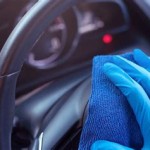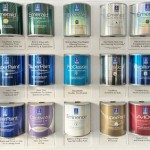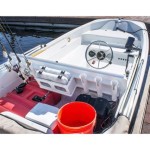The Best Cleaner For Car Interior Plastic Trim And Doors
Maintaining the interior of a vehicle is crucial for both aesthetics and longevity. Plastic trim and doors, being prominent features within the cabin, require regular cleaning and protection to prevent fading, cracking, and staining. Selecting the appropriate cleaning product is paramount to achieving optimal results without causing damage to these surfaces. This article explores various cleaning options and their suitability for car interior plastic, aiming to provide a comprehensive guide for car owners.
Car interior plastics are often exposed to a range of environmental factors, including ultraviolet (UV) radiation from sunlight, extreme temperature fluctuations, dust, dirt, and spills. These factors can contribute to the degradation of the plastic over time, leading to discoloration, brittleness, and an overall aged appearance. Therefore, a good cleaner should not only remove dirt and grime but also offer some degree of protection against these environmental elements.
The automotive detailing market offers a vast array of cleaning products specifically formulated for interior plastics. These products range from general-purpose cleaners to specialized solutions designed for specific types of plastic or finishes. Understanding the different types of cleaners and their properties is essential for making an informed decision.
Understanding Different Types of Cleaners
Several categories of cleaning products are available for car interior plastics, each with its own advantages and disadvantages. These categories include all-purpose cleaners, dedicated plastic cleaners, protectants, and natural cleaning solutions.
All-purpose cleaners are designed to be versatile and can be used on a variety of surfaces. While convenient, some all-purpose cleaners may be too harsh for delicate interior plastics. Strong solvents or alkaline ingredients can strip away protective coatings, causing discoloration or damage. It is crucial to test an all-purpose cleaner on an inconspicuous area before applying it to the entire surface.
Dedicated plastic cleaners are specifically formulated for use on automotive plastics. These cleaners typically contain a blend of surfactants and mild solvents that effectively remove dirt and grime without harming the plastic. They often include UV inhibitors to help protect against sun damage and prevent fading. Dedicated plastic cleaners are generally a safer and more effective option compared to all-purpose cleaners.
Protectants are designed to not only clean but also provide a protective layer against environmental factors. These products often contain polymers or waxes that create a barrier against UV radiation, moisture, and dust. Protectants can help to maintain the appearance of the plastic and prevent it from drying out and cracking. However, some protectants can leave a greasy or shiny residue that may not be desirable for all users.
Natural cleaning solutions are becoming increasingly popular as consumers seek eco-friendly alternatives. These solutions often contain ingredients such as vinegar, baking soda, and citrus extracts. While natural cleaners can be effective for removing light dirt and grime, they may not be as powerful as chemical-based cleaners for tackling more stubborn stains or heavy soiling. It's also important to research the specific effects of natural ingredients on different types of plastics, as some may cause discoloration or damage over time.
Key Ingredients to Consider
When selecting a cleaning product for car interior plastic, it is important to pay attention to the ingredient list. Certain ingredients can be beneficial, while others should be avoided. Understanding the role of various ingredients can help you make a more informed decision.
Surfactants are a key component of most cleaning products. They work by reducing the surface tension of water, allowing it to penetrate dirt and grime more effectively. Surfactants also help to lift dirt away from the surface and keep it suspended in the cleaning solution. Choose cleaners with gentle, non-ionic surfactants to minimize the risk of damage to plastic surfaces.
Solvents are used to dissolve stubborn stains, grease, and oil. However, strong solvents can be harsh on plastics, causing them to dry out, crack, or discolor. Avoid cleaners that contain harsh solvents such as acetone, toluene, or xylene. Instead, look for cleaners that contain milder solvents such as isopropyl alcohol or citrus-based solvents.
UV inhibitors are essential for protecting plastic from sun damage. These ingredients absorb or reflect UV radiation, preventing it from penetrating the plastic and causing fading or discoloration. Look for cleaners that explicitly state they contain UV inhibitors or stabilizers.
Anti-static agents help to reduce the buildup of static electricity on plastic surfaces. This can help to prevent dust and dirt from clinging to the plastic, keeping it cleaner for longer. Cleaners with anti-static properties can be particularly beneficial for cars parked in dusty environments.
Ingredients to avoid include strong acids, alkalis, and abrasive particles. These ingredients can damage plastic surfaces, causing scratches, discoloration, or etching. Also, avoid cleaners that contain silicone-based products if you plan to apply paint protection film or window tint. Silicone residue can interfere with the adhesion of these products.
Proper Cleaning Techniques
Even the best cleaning product will not deliver optimal results if it is not used correctly. Proper cleaning techniques are essential for achieving a clean and protected interior plastic surface.
Start by vacuuming the interior to remove loose dirt, dust, and debris. This will prevent these particles from scratching the plastic surface during the cleaning process. Pay particular attention to crevices and hard-to-reach areas.
Apply the cleaning product to a microfiber cloth, rather than directly to the plastic surface. This will help to prevent overspray and ensure that the product is evenly distributed. Use a clean, soft microfiber cloth to avoid scratching the plastic.
Gently wipe the plastic surface with the damp microfiber cloth, using light pressure. Avoid scrubbing or applying excessive force, as this can damage the plastic. Work in small sections to ensure that the cleaner is evenly applied and does not dry out before being wiped away.
Use a separate clean, dry microfiber cloth to wipe away any excess cleaner. This will help to prevent streaks and leave the surface looking clean and shiny. If necessary, repeat the cleaning process to remove stubborn stains or dirt.
For textured plastic surfaces, use a soft-bristled brush to gently scrub the dirt out of the crevices. Be careful not to damage the plastic by using too much pressure.
After cleaning, apply a plastic protectant to help maintain the appearance of the plastic and protect it from environmental factors. Follow the manufacturer's instructions for applying the protectant. Allow the protectant to dry completely before using the car.
Regular maintenance is key to keeping car interior plastic looking its best. Wipe down the plastic surfaces with a damp microfiber cloth on a regular basis to remove dust and dirt. This will help to prevent buildup and make cleaning easier in the long run.
Always test any cleaning product on an inconspicuous area before applying it to the entire surface. This will help to ensure that the product does not damage or discolor the plastic.
By following these guidelines, car owners can effectively clean and protect their vehicle's interior plastic trim and doors, maintaining a pristine and comfortable driving environment.

Best Interior Trim Cleaners 2024 Auto Express

How To Super Clean Your Interior Dashboard Center Console Door Panels Glass

How To Clean Interior Plastic Autobead

Best Car Interior Cleaners For 2024 Tested

Best Cleaner For Car Interior Plastic Results Mind Blown

How To Clean Interior Plastic Trim Autoblog Details

How To Thoroughly Clean Plastic Surfaces Of Car Interior Detailing Like A Pro Series

Clean Car Door Panels In Less Than 5 Minutes

3 Ways To Clean Car Plastic Wikihow

11 Best Car Interior Cleaner 2024 Autozone
Related Posts








